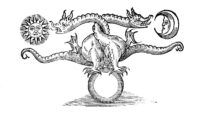A powerful urge towards wholeness and unity drives human behavior, while at the same time an equally powerful urge towards independence and autonomy is also at play. In general terms, such forces may be categorized as the feminine and masculine principles.
In its healthy aspect the feminine principle manifests as creative, unifying and nurturing and in its unhealthy aspect repetitive, smothering, and discouraging of individual initiative. The healthy masculine principle manifests as active, systematic, and goal-oriented, and when unhealthy as violent, self-righteous and rigid. Both feminine and masculine principles are always at work within both sexes, and tend towards establishing equilibrium. When equilibrium is lost, one or the other principle not balanced against the other, personality becomes distorted and damaging to oneself and others. At the same time, the dominance of the unhealthy aspect of one principle brings forth a natural longing for the healthy balancing aspect of the other.
Just as individual personalities may become distorted, so cultures and societies distort when either principle is silenced or pushed deeply into the shadows. Cultures too heavily weighted to unhealthy aspects of the feminine principle may become insular to the point of completely destroying individuality, giving rise to despotic regimes devoted to preservation of The State, such as North Korea. Jungian psychotherapist and author Gareth Hill, Phd. (whose work largely informs this column) names such cultures “matrivalent” and notes that a society can be matrivalent even when men rule. Conversely, cultures that are dominated by unhealthy aspects of the masculine principle, “patrivalent” societies, focus unduly on individual rights to the detriment of the collective good, which leads to economic and ethnic imbalance, rigidity in the rule of law, plutocracy and governing gridlock. Sound familiar?
Both individual and collective life are in a constant state of psycho-dynamic change. Accordingly, Hill notes, each psyche traverses through feminine and masculine aspects, seeking equilibrium that at best is only temporary. Thus individuals display potential for personal growth, which accompanies equilibrium, but also potential for getting stuck in unhealthy patterns like violence or addiction, which indicates a life out-of-balance and loss of equilibrium.
At work in larger society, the principles appear pendulum-like; as the cultural landscape changes society either comes to terms with it comfortably or eventually undergoes upheaval and disruption. An overly patrivalent society reacts rigidly to social change, but the healthy feminine principle eventually undermines such rigidity; the recent election trend granting equal marriage rights to the gay and lesbian community is an example. If society is overly matrivalent, the healthy masculine principle activates movement towards freedom and independence, as is happening in the Arab Middle East.
Western cultures can be properly called primarily patrivalent, while in general Eastern cultures remain strongly matrivalent. Notably, in ancient Greek mythology, many gods and goddesses manifest in both masculine and feminine forms embodying both aspects, thereby encoding messages about equilibrium. Similarly, Tibetan Buddhist deity figures are depicted as embracing male and female entities, the enlightened aspects of masculine and feminine in union, a recognition that the integration of both masculine and feminine principles are essential for healthy spiritual and societal development.
You may see these principles at work within yourself; I certainly do. To the extent I can be aware of traversing through them, I may avoid the unhealthy aspects of either and save myself and those around me from exposure to my most uneven moments.




